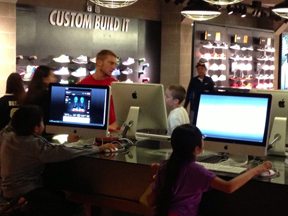Editor’s note: This is “Part 3″ of a three-part series on how the mobile revolution is affecting ecommerce. “Part 1: Shopping Trends” and “Part 2: Channel Trends” we published previously.
In “Part 1” and “Part 2” of this EvRolution series, I’ve addressed consumer shopping trends and how larger global and web-only retailers are responding to new consumer demands. This article focuses on what small to mid-sized ecommerce merchants and smaller brand manufacturers can do to stay competitive.
Products
- Lower your cost of goods sold. Buy your products at the lowest cost possible. Consider sourcing directly from manufacturers and privately labeling your products if possible. Consider stocking inventory for popular items if you drop ship. Negotiate bulk discounts. Price competition is getting fierce as all the consumer channels compete against one another. You need to have the lowest COGS possible.
- Optimize your pricing. The consumer’s price is determined by the market. Even brands you sell may be using online promotions in their stores. Use tools like WisePricer, BI360, Monsoon Commerce, or others to monitor competitor and marketplace pricing and assortment. Find your optimal product mix and continually monitor your prices, either manually or through automation.
- Add more relevant content. Add relevant content to your product descriptions and details. Try using video. Add alternate images. Alter your content for alternate channels if necessary to optimize sales there.
- Get the mix right. Make sure your product assortment matches your customer base or channel. If you have a Walmart customer, so to speak, you don’t need to sell Tiffany products. Also, remember it’s important to have a range of price and quality in your assortment.
- Add niche products. Even if you sell mass-market products, you will want add niche products as up-sells or cross-sells wherever possible. You will likely find better margins that will help offset the lower margins of mass market products that are highly price competitive.
- Stay ahead of the seasons. Be sure to order your seasonal products well in advance to ensure availability. Prep them ahead of time and be ready to promote at the same time you see the big online retailers engage, or even before.
Marketing
- Innovate. Your larger competitors innovate every day, you need as well. Try remarketing ads, try different promotions, do a sweepstakes or contest on social media to capture new email subscribers. Try Google Product Listing Ads. You can experiment on a small scale and see what works before you spend a lot of money.
- Implement multichannel strategies. I discussed this in more depth, at “Multichannel Marketing Key for Reaching Online Shoppers,” a recent article. But make sure your products appear where your target customers shop — which is online, on their smartphones, and on tablets. They likely start with Amazon, Google search, Google Shopping, Pinterest, or even Instagram and Facebook.
- Create loyalty programs. It’s cheaper to sell to an existing customer than it is to find a new one. Find a way to increase your customer loyalty and retention. If you spend $10 per acquisition in your pay-per-click campaigns — on the low end for most retailers —can you afford to give a client a 15 percent discount on a $100 order? It’s probably worth considering. Offering free shipping on a $100 order for repeat customers would likely be a good idea. Free returns might be an easy reward for your loyal customers. Define a specific program and make it exclusive for members.
- Go social. Consumers want to shop with friends. Set up a store on a social shopping site like Wanelo. Build up your Pinterest boards — many merchants are seeing high conversion rates there. Try Instagram. I recently spoke with a merchant who was able to get more than 20,000 followers on Instagram before launching his online store, using an innovative photo campaign and sweepstakes. Use automated tools to simultaneously post on Facebook and Twitter. Stay fresh and stay committed.
- Offer free shipping. Be ready to offer this as a standard shipping method. Build it into the price of your product or cost of doing business. Exceptions might be orders of less than $25 or so. Expedited shipping is the new norm, so consider offering discounted 2-day shipping. You may find that possible with the new Priority Mail deliveries from USPS.
- Consider hassle free returns. It’s tough for a small merchant to pay for return shipping, but it may offer you a competitive advantage. If your return rates are very low, you may want to experiment with the concept. Start with existing customers and see what happens.
- Create new markets. Many smaller online retailers are expanding their sales to other countries. It’s relatively easy, for example, for U.S.-based merchants to experiment with other English speaking countries like Canada, the United Kingdom, Australia, and New Zealand. Research carefully as there may be many new challenges for you, but it may be a good way to expand if you have healthy margins and your product is in demand in those countries.
- Localize for Spanish in the U.S. Another way some retailers are growing their revenue is by offering their online store localized in Spanish in the U.S. to attract the growing buying power of the Hispanic population in the U.S.
- Add a physical store. Did I just say that? You bet. Many small brand manufacturers are adding physical stores. I expect some smaller online retailers may do the same, especially if they maintain their own inventory. Brick-and-mortar retailers are also adding online stores. Smaller ecommerce-only merchants can do it in reverse. Order online, offer free pickup at the front desk. You may grow a local presence and get some valuable direct customer contact.
- Offer online coupons. In addition to coupons you may offer in your own promotions, consider joining a site like RetailMeNot or Coupons.com. You may attract new customers.
Online Store
- Offer a mobile store. It’s time to optimize your store for smartphones and tablets. Optimize your email promotions as well. Mid-sized online retailers may want to consider a shopping app for the iPad.
- Review your ecommerce platform. Are you still running the same user interface as when you launched eight years ago? Consider a complete review of your online cart and platform. There are many new options that have been introduced and upgraded in the last 12 months. Most offer software-as-a-service licensing, which may lower your cost. New merchandising features, built-in order management, marketing automation, and other enhancements may be making your existing store obsolete.
- Accessorize your cart or platform. Even if your online store is a year old and the user interface is world class, look at other ways to improve your customer experience. Consider adding online chat to improve your conversion rate and increase your order values. Add personalization to your store. Automate your store with dynamic pricing. There are many third party products that easily integrate with most shopping carts to improve your revenue generation.
- Experiment with your store. Try new things every month. Use A/B and multivariate testing to try new promotions, new shopping cart designs, checkouts, and color schemes. Be analytical and let the results drive your decisions. Your large competitors are doing A/B testing every single day. A 1 percent improvement in your conversion rate is enormous. A .5 percent improvement is significant. Those types of gains are possible through consistent testing.
- Add alternative payments. If you accept only credit cards, consider adding PayPal and vice versa. We’ll likely see new payment methods from many other sources. Evaluate your products and customers. eBay shoppers use PayPal. Amazon shoppers may prefer Payments by Amazon. Give your shoppers choices.
- Review your customer experience. Regardless of your platform or cart, look at the customer experience in your store. Is if fast? Can you easily find products? Can a shopper start on order on her iPhone and then complete the order later on her laptop? Do you offer a one-step checkout? Do you offer a mini-cart? Do you have image zoom and pan? Is product availability included in your online store? Do you have a shipping estimator in the shopping cart? These are important features for the modern shopper.





